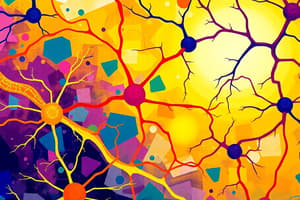Podcast
Questions and Answers
What is a reflex?
What is a reflex?
- An involuntary and instantaneous movement in response to a stimulus (correct)
- A learned behavior over time
- A slow reaction to a stimulus
- A voluntary action in response to a stimulus
What is a reflex arc?
What is a reflex arc?
The neural pathway that mediates reflex action.
The ______ controls internal organs.
The ______ controls internal organs.
Autonomic reflexes
Which type of reflex arc consists of only 2 neurons?
Which type of reflex arc consists of only 2 neurons?
What is meant by reflex time?
What is meant by reflex time?
What is laterality in humans?
What is laterality in humans?
Which reflex involves the use of sensory fibers in joints, tendons, and muscles?
Which reflex involves the use of sensory fibers in joints, tendons, and muscles?
Match the type of reflex with its description:
Match the type of reflex with its description:
Stretch reflex is characterized as what type of reflex?
Stretch reflex is characterized as what type of reflex?
The ______ detects muscle tension.
The ______ detects muscle tension.
What is the function of a muscle spindle?
What is the function of a muscle spindle?
Flashcards are hidden until you start studying
Study Notes
Reflexes Overview
- Reflex: Involuntary, instantaneous movement triggered by a stimulus.
- Often mediated through a reflex arc, enabling automatic responses.
Reflex Arc Components
- Sensory Receptor: Detects the stimulus.
- Afferent Nerve: Carries the sensory signal to the spinal cord or brain.
- Integrative Center: Integrates sensory input and generates motor output.
- Efferent Nerve: Transmits the motor signal to the body.
- Motor Effector: Executes the response.
Classification of Reflexes
-
By Effector:
- Autonomic Reflexes: Regulate internal organs (e.g., glands, heart).
- Somatic Reflexes: Control skeletal muscle movements.
-
By Number of Synapses:
- Monosynaptic Reflex: Involves 2 neurons and 1 synapse.
- Polysynaptic Reflex: Involves multiple neurons connected by interneurons with 2 or more synapses.
-
By Type of Sensory Receptor:
- Exteroceptive: Receives stimuli from the external environment.
- Interoceptive: Receives stimuli from within the body.
- Proprioceptive: Receives information on body position and movement.
Reflex and Reaction Times
- Reflex Time: Interval between the stimulus onset and reflex response.
- Reaction Time: Delay between stimulus onset and a voluntary response.
Laterality
- Refers to the human preference for one side of the body over the other.
Somatic Proprioceptive Reflexes
- Utilize sensory fibers from joints, tendons, and muscles, integrating info in the spinal cord.
- Primarily unconscious, providing feedback on joint position and muscle tension.
- Includes important stretch reflexes.
Somatic Exteroceptive Reflexes
- Utilize skin receptors reacting to external stimuli (pain, temperature).
- Mostly polysynaptic, integrating protective mechanisms (withdrawal, coughing, sneezing).
Stretch Reflex
- A monosynaptic reflex that maintains muscle length and responds to muscle stretching.
- Relies on muscle spindle and Golgi tendon receptors for information.
Muscle Spindle Functionality
- Monitors muscle length and the rate of change in length.
- Central region acts as a sensory receptor; peripheral region contains muscle fibers that respond to neural stimulation.
- Steps:
- Detects muscle stretch.
- Sends impulse via Ia afferent fibers to the spinal cord.
- Activates alpha motor neurons, causing contraction.
Golgi Tendon Organ
- Senses tension within muscle tendons.
- Prevents excessive tension through an inhibitory reflex mechanism.
- Steps:
- Detects muscle tension.
- Sends impulses via Ib sensory fibers to the spinal cord.
- Engages inhibitory interneurons, leading to alpha motor neuron inhibition.
- Results in muscle relaxation and reduced tension.
Studying That Suits You
Use AI to generate personalized quizzes and flashcards to suit your learning preferences.




